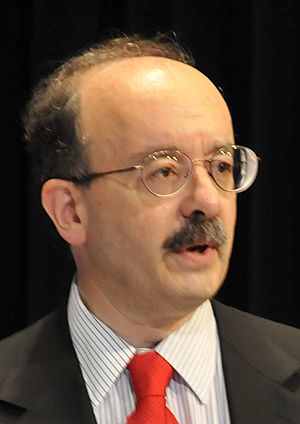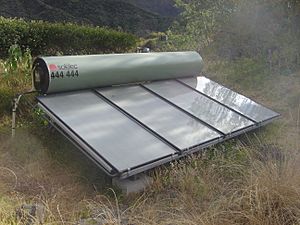Amory Lovins facts for kids
Quick facts for kids
Amory Lovins
|
|
|---|---|

Lovins in 2011
|
|
| Born |
Amory Bloch Lovins
November 13, 1947 Washington, D.C., U.S.
|
| Occupation | Writer, advocate, scientist |
| Known for | Advocacy of efficient energy use and soft energy paths |
| Awards | Order of Merit of the Federal Republic of Germany (Bundesverdienstkreuz) |
Amory Bloch Lovins (born November 13, 1947) is an American writer, scientist, and expert on energy. He is known for his ideas about using energy wisely and switching to clean, renewable power sources. For many years, he was a leader at the Rocky Mountain Institute, an organization that works on these topics.
Lovins has always championed using energy efficiently. He also supports using energy from sources like the sun and wind. He believes energy should be made close to where it's used. He even came up with the idea of a "negawatt revolution." This means saving energy is just as good as making new energy. In the 1990s, he helped design a super-efficient car called the Hypercar. He has written many books, including Reinventing Fire and Natural Capitalism.
Contents
Early Life and Learning
Amory Lovins was born in Washington, DC. His father was an engineer, and his mother worked in social services. His sister, Julie Beth Lovins, is a computer language expert. She created an important method for matching words.
In 1964, Lovins started college at Harvard College. After two years, he moved to Oxford University in England. He became a research fellow there in 1969. He left Oxford in 1971 without a degree. This was because the university would not let him study energy for his advanced degree. Lovins then moved to London to continue his energy work. He returned to the United States in 1981 and settled in Colorado in 1982.
Lovins' grandparents came to the United States from villages in Ukraine. Many of his relatives were sadly killed by German Nazis in 1941.
Amory Lovins' Work
Early Environmental Work
From 1965 to 1981, Lovins spent his summers guiding trips in the White Mountains of New Hampshire. He also took photos for a book about the area. In 1971, he wrote a book about Snowdonia National Park in Wales. This book was requested by David Brower, who led Friends of the Earth. Lovins worked for Friends of the Earth in Britain for about ten years.
In the early 1970s, Lovins became very interested in how we use resources, especially energy. The 1973 energy crisis made people more interested in his ideas. An essay he wrote for the United Nations became his first energy book, World Energy Strategies (1973). He then wrote Non-Nuclear Futures: The Case for an Ethical Energy Strategy (1975).
Founding the Rocky Mountain Institute
By 1978, Lovins had written six books and advised many groups. In 1982, he and his wife, Hunter Lovins, started the Rocky Mountain Institute (RMI). It is located in Snowmass, Colorado. With their team, the Lovinses worked to promote smart use of resources and sustainable development. This means meeting today's needs without harming future generations.
RMI has worked with many large companies and governments. Lovins also advised the U.S. Department of Energy. Since 1982, RMI has grown into a large "think-and-do tank." It has over 600 staff members and a big budget. RMI has also helped start five successful companies.
Key Ideas and Innovations
The Soft Energy Path
In 1976, Amory Lovins wrote an important article called "Energy Strategy: The Road Not Taken?" He said that the United States had a big choice to make. One path was to keep relying on fossil fuels and nuclear fission. This path had serious environmental risks. The other path, which Lovins called "the soft path," focused on clean, renewable energy. This included wind power and solar power. It also meant saving energy and using it more efficiently.
In October 1977, The Atlantic magazine featured Lovins' ideas on its cover. He believes that soft energy paths are more "gentle, pleasant, and manageable." This means they are better for people and the planet.
A film called Lovins on the Soft Path was made about Amory and Hunter Lovins. It won several awards for science and environmental films.
Why Nuclear Power Has Limits
Lovins has pointed out that nuclear power plants can sometimes stop working unexpectedly. This can happen for long periods. For example, in the United States, many nuclear plants have closed early due to problems or high costs. Even working plants must shut down for maintenance and refueling. This happens for about one month out of every 18 months.
Lovins also explains that nuclear plants have another problem. For safety, they must shut down instantly if there's a power failure. But they cannot be restarted quickly. For example, during a big power outage in 2003, nine U.S. nuclear units had to shut down. Their power output was very low for days after restarting.
In 2011, Lovins wrote that nuclear power is unique. He said it's the only energy source where accidents or bad intentions can harm many people far away. He also noted that its materials can be used to make nuclear bombs. He believes nuclear plants are too slow and costly to build. This makes them less helpful for fighting climate change. He also said that placing 54 reactors in an earthquake and tsunami zone, like Japan, was unwise.
In 2014, Lovins commented on the United Kingdom's plan for new nuclear power stations. He called it "unbelievable" and "economically daft." He said the price for nuclear power was much higher than for new wind or solar power. He believes nuclear prices only go up, while renewable energy prices come down.
The Negawatt Revolution

A negawatt is a unit of power that is *saved*. It's like the opposite of a watt. Amory Lovins has strongly supported a "negawatt revolution." He argues that people don't just want electricity. They want the services electricity provides, like hot showers, cold drinks, or lit rooms. These services can be cheaper if electricity is used more wisely.
The Hypercar Concept
In 1994, Amory Lovins came up with the idea for the Hypercar. This car would be super light. It would have a sleek, aerodynamic shape made from advanced materials. It would also have a hybrid drive system. Designers believed the Hypercar could use three to five times less fuel than regular cars. It would still perform well, be safe, comfortable, and affordable.
In 1999, RMI started a company called Hypercar Inc. to develop this idea further. The company later changed its name to Fiberforge. This new name reflected its goal of making strong, lightweight car parts more affordably. Lovins says that the Hypercar idea started becoming real in 2014. This was when cars like the all-carbon electric BMW i3 and the super fuel-efficient Volkswagen XL1 were produced.
Citizen Power
Lovins sees his energy ideas as practical, not just "green" or political. He supports private enterprise and free market economics. He points out that even companies like Rupert Murdoch's News Corporation have become carbon-neutral. This saved them millions of dollars. Lovins believes that large organizations can sometimes get "stuck." He supports the growth of "citizen organizations" around the world. He feels these groups are bringing new life and change.
Awards and Recognition
Amory Lovins has received many awards for his work. He was chosen as a Fellow of the American Association for the Advancement of Science in 1984. He also became a Fellow of the World Academy of Art and Science in 1988. Some of his major awards include the Right Livelihood Award, the Blue Planet Prize, and the Volvo Environment Prize. In 1998, he received the 4th Annual Heinz Award in the Environment.
Lovins also received the Time Hero for the Planet award. He was given a MacArthur Fellowship in 1993. This is a special award for talented individuals. He is an honorary member of the American Institute of Architects. In 2009, Time magazine named him one of the world's 100 most influential people.
On March 17, 2016, Lovins received a high honor from Germany. He was given the Bundesverdienstkreuz 1. Klasse. This award recognized his ideas, especially his "soft energy" concept. These ideas helped Germany's shift to renewable energy, known as the Energiewende.
Personal Life
In 1979, Amory Lovins married L. Hunter Sheldon. She is a lawyer and social scientist. They separated in 1989 and divorced in 1999. In 2007, he married Judy Hill, who is a landscape photographer.
Books by Amory Lovins
Here are some of the books Amory B. Lovins has written or co-written:
- World Energy Strategies: Facts, Issues, and Options (1975)
- The Energy Controversy: Soft Path Questions and Answers (1979)
- Non-Nuclear Futures: The Case for an Ethical Energy Strategy (with John H. Price) (1980)
- Least-Cost Energy: Solving the CO2 Problem (1982)
- Brittle Power: Energy Strategy for National Security (with L Hunter Lovins) (1982, re-released 2001)
- The First Nuclear World War (with Patrick O'Heffernan; L Hunter Lovins) (1983)
- Reinventing Electric Utilities: Competition, Citizen Action, and Clean Power (1996)
- Factor Four: Doubling Wealth – Halving Resource Use: A Report to the Club of Rome (1997)
- Natural Capitalism (2000)
- Small Is Profitable (2003)
- The Natural Advantage Of Nations: Business Opportunities, Innovation And Governance in the 21st Century (2004)
- Let the Mountains Talk, Let the Rivers Run: A Call to Save the Earth (2007)
See also
 In Spanish: Amory Lovins para niños
In Spanish: Amory Lovins para niños
- Anti-nuclear movement in the United States
- Energy security and renewable technology
- Hermann Scheer
- Mark Z. Jacobson
- Renewable energy commercialization


